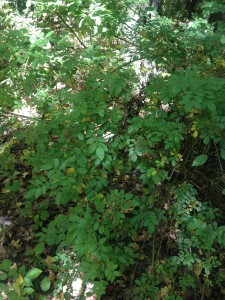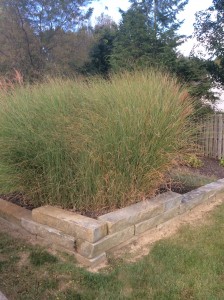-
Plants in a specific family
-
Lamiaceae (mint)
-
Conserved characters that you used to determine the family identification. These characters should be clearly illustrated in your photo(s)
-
(most) are pubescent
-
alternate serrate crenate (having rounded scallops) leaves
-
aromatic
-
5 fused sepals, 5 fused petals
-
petals zygomorphic – bilabiate (two lipped – 2 petals on one lip, 3 on the other)
-
2 or 4 stamen
-
2 fused (deeply lobed) or 4 unfused carpels
-
1 stamen
-
2 stigma lobes
-
-
name: Mentha piperita – peppermint
-
location: 2623 1/2 Neil ave, a garden
-
-
-
Rosaceae (rose)
-
conserved characters that you used to determine the family identification. These characters should be clearly illustrated in your photo(s)
-
alternate serrate leaves
-
5 sepals and petals
-
many stamen (fused in apples)
-
superior ovary (except apples which have inferior ovaries)
-
hypathium (cup of fused sepals and petals half surrounding the ovary)
-
-
name: Rosa sp
-
location: Chadwick Arboretum


-
-
-
Plants that are on (or will be on) your sight ID list
-
Phytolacca americana (pokeweed)
-
location: Neil Ave
-
characters used to recognize the species:
-
racemes of white or pinkish flowers (sepals petal-like, no petals)
-
dark purple berries or green gynoceum
-
alternate, entire leaves
-
burgundy red stems and stalks on flowering parts
-
-
-
-
Cornus sp (dogwoods)
-
location: behind Jennings
-
characters used to recognize the species: Simple entire leaves, viens curving as they reach the leaf margin, four parted flowers, drupe seeds
-
-
-
-
Specific characters of plants
-
a plant with a gynoecium composed of many unfused carpels
-
name: Duchesnea indica
-
location: side lot of 2531 Neil ave
-
a definition of the character: carpels are the ovule containers in the ovary, they are fused when their fleshy areas are not easily separated. In the case of this plant (fruit shown here) the unfused carpels will become separate achenes
-
-
-
a plant with a gynoecium composed of five carpels
-
name: crab apple – Malus sp
-
location: behind Jennings
- a definition of the character: carpels are the ovule containers in the ovary.
-
-
-
Scavenger Hunt Items
Place Plant Scavenger hunt Items here.
Scavenger Hunt around Columbus
Family Identification:
1a.)A Member of the Poaceae family with an explanation of the characters used to determine that family.
Indian grass (Sorghastrum spp.). This family is identified based on the entire leaf margins with parallel venation. These characteristics along with a sheathing leaf, a caryopsis fruit type, and hollow stem are characteristics of this family.
Found outside of Aronoff Laboratory in Columbus, Ohio.
1b.) A member of the Asteraceae family with an explanations of the characters used to determine that family.
Black-eyed Susan (Rudbeckia hirta). This family can be identified because many flowers are in a head that appear to create one larger flower.
This Black-eyed Susan was found at Battelle-Darby Creek Park in Galloway, Ohio.

Black-eyed Susan
Sight Identification:
2a.) Queen Anne’s Lace (Daucus carota). Is easily identified by the small white flowers in an umbel formation that is typically 2-3feet tall. The plant is also known as a wild carrot.
This Queen Anne’s lace was found at Battelle-Darby Creek Park in Galloway, Ohio.
2b.) Sugar Maple (Acer saccharinum). Is easily identified because of its palmate venation and leaves with 5 lobes. In the fall, the coloration of the leaves are brilliant shades of red, orange and yellow.
This Sugar Maple is located outside of the Ohio Union in Columbus, Ohio.
Character Items:
3a.) A plant with simple, alternate, serrate leaves.
American Hornbeam (Carpinus caroliniana). Is a tree that displays leaves that are simple, alternate and serrated. Simple leave are leaves that have a bud located near a single leaf stem. Alternate leaves are leaves that are arranged on varying sides of a branch (ie. they are not located across from one another, but staggered down the branch). Serrate leaves indicate leaves that have “teeth” or edges present.
This American Hornbeam was found outside of Aronoff Lab in Columbus, Ohio.
3b.) A plant with simple, opposite, and entire leaves.
Dogwood (Cornus spp.). Is a plant with simple, opposite and entire leaves. Simple leaves are leaves that have a bud located near a single leaf stem. Opposite leaf arrangement is when the leaves are located directly across from one another on a branch. Entire leaves are leaves that have smooth, whole edges.
This tree was found outside of Aronoff Lab in Columbus, Ohio.
Scavenger Hunt Plants
A plant that produces a panicle: A panicle is a type of inflorescence that that is a branched raceme, but rather than one flower of each branch there are multiple flowers on each branch.
Tendrils: Tendrils are modified plant parts that form threadlike structures that wrap around things to hold up the plant. These are leaflet tendrils on a clematis.
Lamiaceae: Opposite branching, hairy stem, square stem, aromatic.
Apiaceae: Compound umbel, alternate leaves, petioles sheath stem, 5-merous flowers.
Quercus alba: Alternate simple deeply lobed leaves with rounded tips, buds clustered at the end of twigs, single stem
Aesculus glabra: Palmately compound leaves with 5 leaflets, buds scaley but not sticky or pubescent.
Scavenger Hunt
1a. A member of the Asteraceae with an explanation of the characters that you used to determine the family identification.
The inflorescence of Asteraceae is distinctive. Has a prominent head, a cluster of flowers that appear to be a single flower.
Specimen: Goldenrod (Solidago sp.)
Location of specimen: Mt. Sterling, OH
.
1b. A member of the Poaceae with an explanation of the characters that you used to determine the family identification.
Field Corn (Zea sp.) is a member of the Poaceae family because the fruit is a caryopsis (the seed coat of a corn kernel is fused to the fruit wall). This family has leaves with entire margins and parallel venation. Other characters include: hollow stems, and open leaf sheaths. Location of specimen: Mt. Sterling, OH
2a. Multiflora rose (Rosa multiflora)
Shrub. Compound leaves with 5-9 leaflets and feathered stipules. Other ID characters include reddish/purple hips and stout prickles. Location of specimen: Waterman Farm, OSU.
2b. Indian grass (Sorghastrum nutans)
The base of the leaf has a “rabbit ears” structure. Leaves with entire margins and parallel venation. Other ID characters include: hollow stems, and open leaf sheaths. Location of specimen: OSU
3a. A plant with ovate leaves:
Ovate: a leaf with the shape of an egg.
Specmien: Tri colored beech (Fagus sylvatica ‘Roseo-marginata’)
Location of specimen: Upper Arlington, OH
.
3b. A plant with a gynoecium composed of five carpels
Gynoceium: The female structures of a flower, collectively.
Carpel: The innermost whorl of a flower
Specimen: Geranium (Geranium sp.)
Location of specimen: Upper Arlington, OH
Taraxacum officinale
Specific plant characters
-A plant with opposite compound leaves
Location: Green Ohio
This plant has opposite compound leaves. This means that the leaves are arranged in an opposite fashion (they face in two different directions coming from the same point). This entire picture is of one leaf but there are many leaflets coming off the same leaf stalk, making this overall a compound leaf.
Phragmites australis
Phragmites australis (common reed)
Location: Green Ohio
Some characteristics I used to recognized this species were the long lanceolate leafs (grass). I also noticed that some parts of this plant were turning light brown, which is also a characteristic of Phragmites australis. Starting in the fall the leaves start to change color and become light brown vs. fully green in the summer months.
Plant in Poaceae family
-A member of the Poaceae with an explanation of the characters that you used to determine the family identification
Location: Green Ohio
I identified this plant to be from the Poaceae family. Some characteristics I used to determine this were the long linear leaves; also, the leaves are alternate with entirely smooth margins.






































